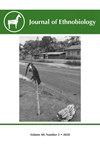Tank Bromeliads as a Water Reservoir Used by Humans: An Important Overlooked Ecosystem Service in Xerophytic Forests
IF 1.3
3区 社会学
Q1 ANTHROPOLOGY
引用次数: 0
Abstract
The Bromeliaceae are known for providing numerous ecosystem services. Tank bromeliads that collect water in the bases of their leaves have been an important source of water for people in semiarid regions such as the Gran Chaco. In this large area characterized by xerophytic vegetation grows Aechmea distichantha, the only Chaquenian terrestrial tank bromeliad. We carried out a literature review on water consumption from this tank bromeliad by people in this region. Then, we analyzed the variations in the amount of water stored in the tanks of plants from observational studies as well as the effects of the amount and frequency of water addition on the hydrology of water retained in the tank from an irrigation experiment study. We found 85 reports on the consumption of water from A. distichantha plants by people, including several Indigenous Groups, Criollos, and Soldiers. According to these reports, the tank accumulates about a liter of relatively fresh and clear water that lasts for several weeks. Our observational study showed a large variation in the amount of water held in the tank among years and sites, and our irrigation experiment showed that even plants receiving low and unevenly distributed rainfall conserved some water in their tanks. All these results support the importance of this tank bromeliad for surviving when moving in Eastern Chaco during dry periods until the beginning of the twentieth century. At present, it seems that people living in sedentarism no longer frequently use it for water provision, highlighting that the relative importance of a plant species for providing ecosystem services depends on the historical context.作为人类水库的槽凤梨:旱生森林中被忽视的重要生态系统服务
凤梨科以提供多种生态系统服务而闻名。在大查科(Gran Chaco)等半干旱地区,水箱凤梨属植物的叶子底部可以收集水分,是人们的重要水源。在这片以旱生植被为特征的大片地区,生长着唯一的沙克世陆生坦克凤梨科植物——aecmea distichantha。我们对该地区居民对这种凤梨的耗水量进行了文献综述。然后,我们从观察研究中分析了植物储水量的变化,以及从灌溉试验研究中分析了加水量和加水频率对储水水文的影响。我们发现了85份关于人们从一种植物中摄入水分的报告,其中包括一些土著群体、Criollos和士兵。根据这些报告,水箱中积累了大约一升相对新鲜和清澈的水,可以持续几个星期。我们的观察研究表明,不同年份和不同地点的储水量存在很大差异,我们的灌溉实验表明,即使是降雨量低且分布不均匀的植物,也会在其储罐中保留一些水分。所有这些结果都支持了这种坦克凤梨在20世纪初的干旱时期在东查科生存的重要性。目前,生活在定居状态下的人们似乎不再经常使用它来提供水,这突出表明植物物种提供生态系统服务的相对重要性取决于历史背景。
本文章由计算机程序翻译,如有差异,请以英文原文为准。
求助全文
约1分钟内获得全文
求助全文
来源期刊

Journal of Ethnobiology
Social Sciences-Anthropology
CiteScore
4.80
自引率
3.40%
发文量
21
审稿时长
>12 weeks
期刊介绍:
JoE’s readership is as wide and diverse as ethnobiology itself, with readers spanning from both the natural and social sciences. Not surprisingly, a glance at the papers published in the Journal reveals the depth and breadth of topics, extending from studies in archaeology and the origins of agriculture, to folk classification systems, to food composition, plants, birds, mammals, fungi and everything in between.
Research areas published in JoE include but are not limited to neo- and paleo-ethnobiology, zooarchaeology, ethnobotany, ethnozoology, ethnopharmacology, ethnoecology, linguistic ethnobiology, human paleoecology, and many other related fields of study within anthropology and biology, such as taxonomy, conservation biology, ethnography, political ecology, and cognitive and cultural anthropology.
JoE does not limit itself to a single perspective, approach or discipline, but seeks to represent the full spectrum and wide diversity of the field of ethnobiology, including cognitive, symbolic, linguistic, ecological, and economic aspects of human interactions with our living world. Articles that significantly advance ethnobiological theory and/or methodology are particularly welcome, as well as studies bridging across disciplines and knowledge systems. JoE does not publish uncontextualized data such as species lists; appropriate submissions must elaborate on the ethnobiological context of findings.
 求助内容:
求助内容: 应助结果提醒方式:
应助结果提醒方式:


